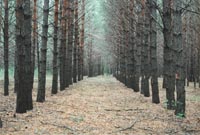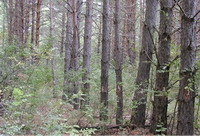|
|
УДК 630*443.3
Morphological Characters of the Circumboreal
Area
Fungi Belonging to Armillaria mellea
sensu lato Complex Download PDF (102
KB)
I.N. Pavlov,
A.G. Mironov,
N.P. Kutafyeva
Siberian State
Technological University,
82 Mira Ave, Krasnoyarsk, 660049, Russia
Volume
XXIV,
Number 1, 2006
Abstract
The performed
investigating a number of keys to identifying the Armillaria species,
developed
for European countries, let revealing the certain distinctive
morphological
features of Armillaria
species’
basidiomes, equally applicable in Siberian conditions. The
morphological study
data have been approved at the territory of Krasnoyarsk City Green
Zone. For
the first time in Siberia, four fungi species of A.
mellea s.l. complex have been identified:
A.
borealis, A. cepistipes, A.
ostoyae, and A.
gallica.
References
- 1.
Courtecuisse,
R., Duhem, B. Mushrooms and toadstools
of Britain and Europe. – London: HarperCollinsPublishers,
1995. - 480 p.
- 2.
Hansen, L.,
Knudsen, H. Nordic Macromycetes. – Vol. 2
(Polyporales, Boletales, Agaricales, Russulales) –
Nordsvamp-Copenhgagen, 1992.
– 474 p.
- 3.
Kalamees, K.
Modern treatment of the Armillaria mellea
groop in Estonia / Tenth congress of European mycologists: Abstracts.
– Tallin,
1989. – P.50.
- 4.
Korhonen, K.
Interfertility and clonal size in the
Armillaria mellea complex // Karstenia. – №18. - 1978.
– P. 31-42.
- 5.
Korhonen, K.
Fungi belonginc to the Genera
Heterobasidion and Armilaria in Eurasia / Грибные сообщества лесных экосистем. – Том 2. –
Москва-Петрозаводск, 2004.
– С. 89-113.
- 6.
Legrand, P.,
Guillaunmin J.J. Armillaria species in
forest ecosystems // Acta o ecologica. – Vol.14. - №3.
– 1993. – P. 390-405.
- 7.
Marxmüller,
H. Honningsvampe // Svampe. - №5. – 1982.
– P.2-10.
- 8.
Marxmüller,
H. Etude morphologique des Armillaria ss.
str. a anneau // Bull. Soc. Myc. Fr. – tome 98. –
fasc. 1. – Paris, 1982. – P.
87-124.
- 9.
Marxmüller,
H. Quelques remarques comlementaires sur
les Armillaries annelees // Bull.
Soc.
Myc. Fr. – tome 103. – fasc. 2. – Paris,
1987. – P. 137-156.
- 10.
Michael, E.H.,
Hennig B. Handbuch für Pilzfreunde.
– Bd. III.–
Jena, 1979.– 464 s.
- 11.
Mohammed, C.,
Guillaumin J.J., Berthelay S. Armillaria
species identified in China and Japan // Mycological research.
– vol. 98. –
part 6. – 1994. – P. 607-613.
- 12.
Moser, M. Die Röhrlinge
und Blätterpilze (Polyporales, Boletales,
Agaricales, Russulales). – Jena: VEB Gustav Fisher Verlag,
1978. – 532 s.
- 13.
Phllips, R.
Mushrooms and other fungi of Great Britain
and Europe. – London, 1981. – 288 p.
- 14.
Shaw III C.G.,
Kile G.A. Armillaria root disease.
Agriculture handbook № 691. – Washington D.C., 1991.
– 231 р.
- 15.
Termorshuizen,
AAD, Arnolds EEF. On the nomenclature
of the European species of the Armillaria mellea group // Mycotaxon.
– Vol. 30.
- 1987. – P.101-116.
- 16.
Velenovsky, D.J. Ceske
houby. – Dil I-V. – Praza, 1920-1922. -
P. 283.
- 17.
Volk, T.J.,
Burdsall, H.H. A Nomenclatural Study of
Armillaria and Armillariella species (Basidiomycotina,
Tricholomataceae). –
Synopsis Fungorum 8. – Oslo, 1995. -121 р.
- 18.
Бурова, Л.Г.
Данные по экологии опенка настоящего (Armillaria mellea (Fr.) Karst. в лесах
Подмосковья // Экология, 1983. - №
4. –
С. 65-68.
- 19.
Ваасма, М.,
Каламеэс, К., Райтвийр А. Макромицеты Кавказского государственного
заповедника.
– Таллин: Валгус, 1986. – 106 с.
- 20.
Васильева, Л.Н.
Агариковые шляпочные грибы (порядок Agaricales)
Приморского края.- Л.: Наука, 1973. – 331 с.
- 21.
Жукова, А.М.
Грибные болезни лесов Верхнего Приобья. – Новосибирск: Наука,
1978. – 242 с.
- 22.
Звягинцев, В.Б.
Распространен-ность, вредоносность грибов комплекса Armillaria в лесах Беларусии и обоснование
лесозащитных
мероприятий: автореф. дис. к.б.н. – Минская область, п.
Прилуки, 2003. –
19 с.
- 23.
Иванов, А.И.
Агариковые грибы-ксилотрофы Пензенской области // Микология и
фитопатология. – том
15. - № 3. – 1981. – С.192-197
- 24.
Лессо, Т. Грибы.
Определитель. – М: Астрель, 2003. –80 с.
- 25.
Любарский, Л.В.,
Васильева А.Н. Дереворазрушающие грибы Дальнего Востока. –
Новосибирск: Наука,
1975. – 163 с.
- 26.
Музыка, С.М.
Грибы северного Присаянья (Состав, экологические особенности и
ресурсы). –
Иркутск: ИрГСХА, 2002. – 154 с.
- 27.
Мухин, В.А. Биота
ксилотрофных базидиомицетов Западно-Сибирской равнины. –
Екатеринбург: УИФ
«Наука», 1993. – 230 с.
- 28.
Радзиевская, М.Г.
Биологическая концепция вида у гименомицетов: род Armillaria / Проблемы вида и рода у грибов.
– Таллин, 1986. –
С.139-146.
- 29.
Рублев, С.И.,
Алексеев, И.А. Комплекс дереворазрушающих грибов лиственницы Сукачева
на пороге
ареала // Лесной журнал. – 2004. - № 6. – С. 13-19.
- 30.
Селочник Н.Н.,
Кондрашова, Н.К. Распространение и вредоносность опенка в
дубравах
Теллермановского леса // Микология и фитопатология, 1991. –
том 25. – вып. 3. –
С. 226-231.
- 31.
Соколов, Д.В.
Корневая гниль от опенка и борьба с ней. – М.: Лесная
промышленность. – 1964. –
183 с.
- 32.
Федоров, Н.И.
Корневые гнили хвойных пород. – М.: Лесная промышленность,
1984. – 160 с.
- 33.
Федоров, Н.И.,
Звягинцев, В.Б. Морфологическое разнообразие опенка осеннего в лесах
Беларуси в
зависимости от породного состава и субстрата произрастания // Лесное
хозяйство:
Труды БГТУ, Сер.1. – Мн., 2001. – Вып. IX. – С. 69-71.
- Шубин,
В.И., Крутов, В.И. Грибы Карелии и Мурманской области
(Эколого-систематический список). – Л: Наука, 1979.
– 107 с.
______________________________
|
|
|





